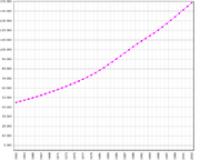Home | Country Demographics | Demographics of Pakistan
|
|
|
This article is about the demographic features of the population of Pakistan, including population density, ethnicity, education level, health of the populace, economic status, religious affiliations and other aspects of the population.Pakistan's estimated population in 2011 is over 187 million making it the world's sixth most-populous country, behind Brazil and ahead of Bangladesh. During 1950 � 2011, Pakistan's urban population expanded over sevenfold, while the total population increased by over fourfold. In the past, the country's population had a relatively high growth rate that has, however, been moderated by declining fertility and birth rates. The population growth rate now stands at 1.6%. Dramatic social changes have led to rapid urbanization and the emergence of megacities. During 1990 � 2003, Pakistan sustained its historical lead as the second most urbanized nation in South Asia with city dwellers making up 36% of its population. Furthermore, 50% of Pakistanis now reside in towns of 5,000 people or more. Pakistan has a multicultural and multi-ethnic society and hosts one of the largest refugee populations in the world as well as a young population. |




 RSS
RSS